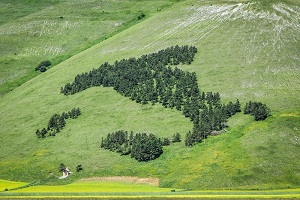Italian pine forst shaped just like Italy

Rome: There’s nothing like being in Italy, and the country’s central region of Umbria is often called il Cuore Verde d’Italia, the “Green Heart of Italy,” for its verdant meadows and rolling hills.
But the green heart of the green heart of Italy might be a single pine forest on an Apennine hillside near Castelluccio. It’s been carefully planted so that you can stand there within the borders of Italy—two times over.
Umbria is the only one of Italy’s 20 regions that doesn’t border the Mediterranean or another country; it’s surrounded by Italy on all sides. On its eastern edge are the Sibillini Mountains, named for the Appenine Sibyl—a legendary oracle who lived in a cave there and dispensed prophecies to medieval travelers.
The breathtaking Piano Grande (“Great Plain”) is a remote upland plateau in the Sibillini Mountains. When glaciers were carving out these valleys, the Piano Grande was once the bottom of a vast lake, but today it’s a karstic basin whose porous limestone holds huge reserves of water. That explains the burst of wildflower color that overtakes the otherwise desolate plateau every spring and summer in the “Fiorita,” when the poppies, daisies, and lilies bloom.
Just a mile above the crumbling medieval village of Castelluccio is a stand of pine trees called the Bosco Italia, which dates back to 1961. In that year, Italy celebrated the centennial of its Risorgimento, the unification of the peninsula into a single nation. Castelluccio was also hosting the tenth Festa della Montagna, an agricultural festival sponsored by the government forestry corps. In a burst of patriotic fervor, the locals dreamed up an ambitious forestry project of their own.
That September, locals built a small chapel on the slopes of Monte Veletta, and then marked off a miniature map of Italy on the hillside, stretching 780 feet from Mont Blanc in the Alps down to the tip of Italy’s tacco, or “boot” heel, in Apulia. They planted hundreds of little pine trees within the borders of their map, and hoped for the best. The seedlings struggled for years to take root, but 50-odd years later, the effect is impressive: a full map of Italy, including Sardinia and Sicily, is etched with trees on the hillside. It’s a way to see all of Italy at once right in the heart of the Appeniens—at roughly 1/5,000th scale.





